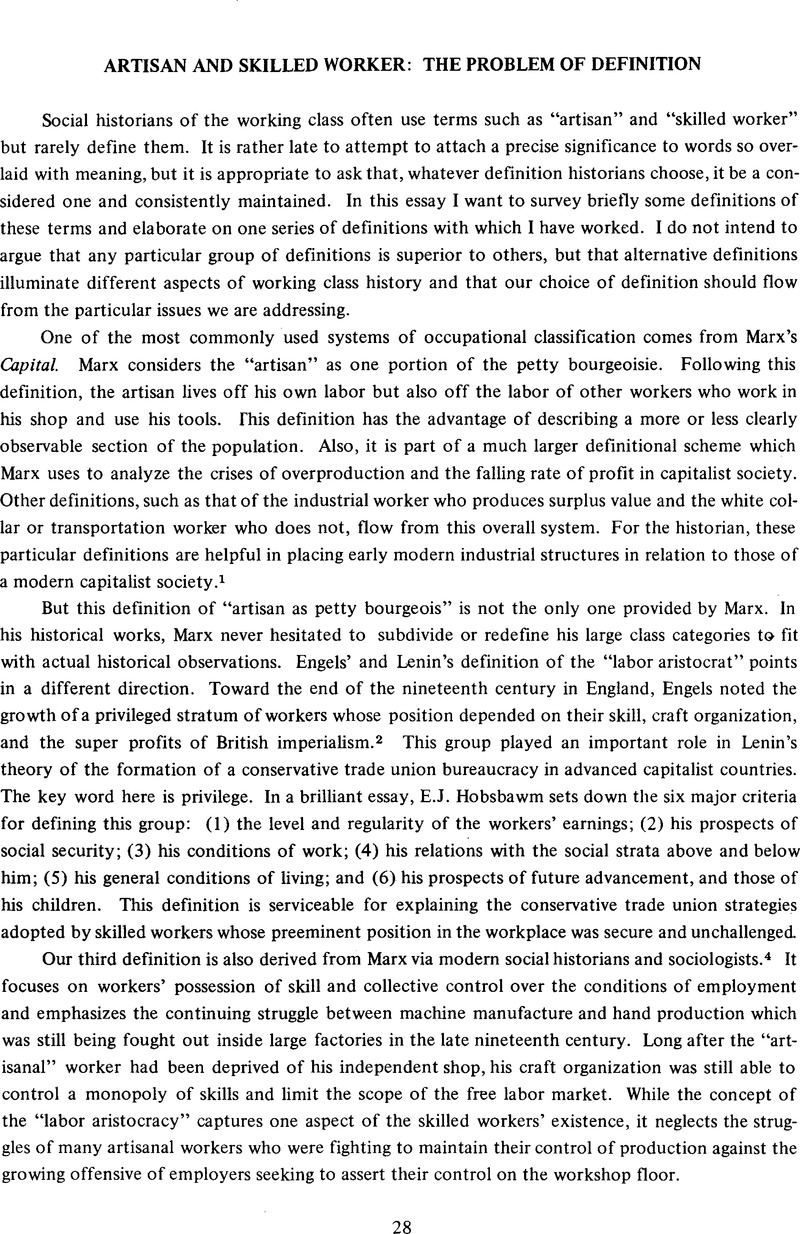Article contents
Artisan and Skilled Worker: The Problem of Definition
Published online by Cambridge University Press: 16 December 2008
Abstract

- Type
- Essays
- Information
- Copyright
- Copyright © International Labor and Working-Class History, Inc. 1977
References
1. On Marx's labor theory of value see Ronald Meek, Studies in the Labor Theory of Value (New York, 1976).Google Scholar For some recent applications: Ron Aminzade, “A Marxist Approach to Occupational Classification,” Working Paper No. 132, Arbor, Ann, Center for Research on Social Organization, 1976, Nicos Poulantzas, Classes in Contemporary Capitalism (London, 1975)Google Scholar, James Stolzman and Herbert Gamberg, “Marxist Class Analysis versus Stratification Analysis as General Approaches to Social Inequality,” Berkeley Journal of Sociology, 18(1973) pp. 28–43Google Scholar, and Wright, Eric Olin, “Contradictory Class Locations,” New Left Review, n.98 (July-August 1968) pp. 3–42.Google Scholar
2. V.I. Lenin, What Is To Be Done? (New York, 1961).Google Scholar
3. Hobsbawm, E.J., “The Labor Aristocracy in Nineteenth Century Britain,” in Workers in the Industrial Revolution, eds. Stearns, Peter N. and Walkowitz, Daniel J. (New Brunswick, 1974) p. 139.Google Scholar
4. Some sociologists and social historians who use one or another element of this third definition are: Scott, Joan W.The Glassworkers of Carmaux, (Cambridge, 1974);Google ScholarSewell, William H.Google Scholar, “The Working Class of Marseilles under the Second Republic,” in Stearns, and Walkowitz, , Workers in the Industrial Revolution, pp. 75–116Google Scholar; Shorter, Edward and Tilly, Charles, Strikes in France 1830-1968 (Cambridge, 1974)Google Scholar; and Touraine, Alain, L'Evolution du travail ouvrier aux Usines Renault (Paris, 1955).Google Scholar Some interesting contributions to the discussion of occupational classification and changes in work structure have been made by students of social mobility: Clyde Griffin, “Occupational Mobility in Nineteenth Century America: Problems and Possibilities,” Journal of Social History, 5 (Spring, 1972); Michael B. Katz, “Occupational Classification in History,” Journal of Interdisciplinary History, 3(Summer, 1972); and Bruce Laurie, Theodore Hershberg, and George Alter, “Immigrants and Industry: The Philadelphia Experience: 1850-1880,” Journal of Social History, 9(Winter 1975).
5. On the education of artisanal workers, George Sturt, The Wheelwrights Shop (Cambridge, (1923) 1974).Google Scholar
6. American labor historians have generally emphasized the restrictive quality of craft unionism, particularly emphasizing its bias against industrial workers, Commons, John R., “American Shoemakers 1648-1895: A Sketch of Industrial Evolution,” Labor and Administration (New York, 1913)Google Scholar and Slichter, Sumner, Union Policies and Industrial Management (Washington, D.C., 1941) chs. 7-9.Google ScholarAlan Dawley has argued persuasively that the opposition between craft and industrial workers in nineteenth century has been overdrawn, Class and Community: The Industrial Revolution in Lynn (Cambridge, 1976). David Montgomery has also argued along similar lines, “Workers' Control of Machine Production in the Nineteenth Century,” Labor History 17 (Fall 1976).Google Scholar
7. See Stinchcombe, Arthur, “Bureaucratic and Craft Administration: A Comparative Study,” Administrative Science Quarterly 4 (Sept. 1959)CrossRefGoogle Scholar and Garden, Maurice, “Ouvriers et artisans au XVIIIe siecle.” Revue d'Historie economique et sociale 48 (1970).Google Scholar
- 9
- Cited by




